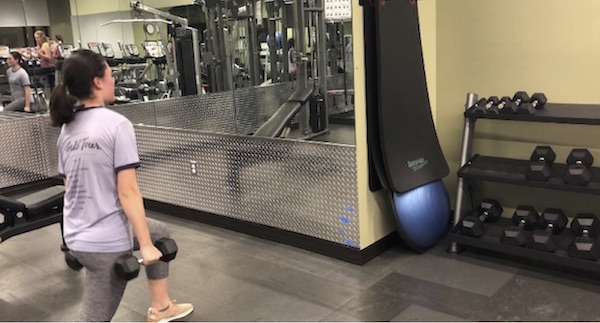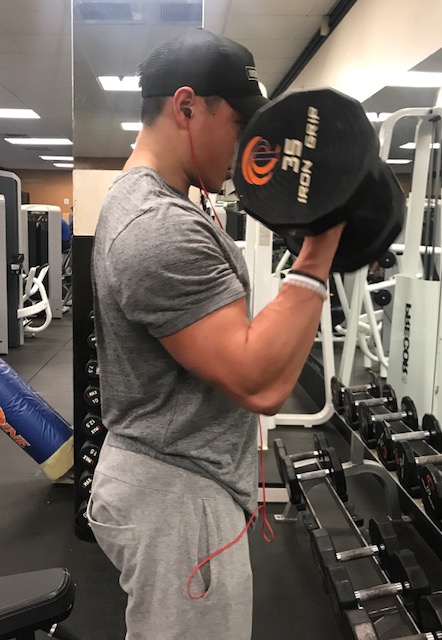
Inspiration can strike anywhere.
But fitspiration, which is primarily delivered via fitness influencers on social media, is changing the way people eat, live and work out.
Social media fitness influencers, while inspiring fitness, can also foster an unrealistic image of what fitness looks like in order to meet society’s beauty standards.
“A lot of individuals follow influencers that they think will provide them with accurate information regarding fitness,” Psychology Professor Jennifer Harriger said. “I’m positive that this information is not accurate.”
A Pepp Post poll of 50 students found that around 39% of students follow fitness influencers on social media and around 54% said these accounts influenced them to work out more frequently.
Although social media is a popular way to stay connected and informed when it comes to health and fitness, many agreed that social media can have damaging effects on body image and fitness.
“Fitness and health are certainly discussed at length through these platforms,” Sports Medicine Professor Brittni Paris said. “And the influence can range from different types of workouts and diets one can try to mental health and encouragement, to following a fitness or health guru in hopes to have a body like theirs one day.”
Social media workout challenges
Social media influencers are known to post workout challenges that last for a certain duration of time. Common challenges include “five-minute ab workout ” or a “ 90-day transformation challenge.”
The poll found that around 47% of people have previously participated in a workout challenge they found on social media and that 34% of people are currently participating in one.
Lydia Maxson, a junior business administration major, wanted to prove to herself she is capable of running long distances since it had previously been something she dreaded. She found a challenge and trained to complete a half marathon.
“I looked for running guides on social media for how to run a half marathon,” Maxson said. “The plan I found was easy to follow and for beginners. I assume it was accurate information because it was similar to other plans I had seen.”
Maxon stopped the challenge before completing a half marathon when her running buddy got injured, but she plans to begin training again soon.
Many people who start workout challenges they found on social media end up stopping them before the challenge is completed.
The poll found that many stopped challenges because they forgot to follow it for a few days, others because they decided the results weren’t obtainable and others because of time constraints.
Fitness influencers often lack the research to back their workouts or lifestyle tips. Senior sports medicine major Kristin Vavaroutsos found this out the hard way when she turned to social media fitness challenges while recovering from a shoulder surgery.
Vavaroutsos’s goal was to maintain her aerobic endurance throughout her recovery.
“I did maintain my endurance, but the exercise program I found on social media did not promote any muscle building, so I ended up losing a lot of muscle that I needed,” Vavaroutsos said.
Many fitness accounts on social media promote fitness regimens with pictures and videos, not science.
“The scientific data is less accessible to the public, leaving social media as one of the main influences on fitness and health in society, ” Vavaroutsos said.
Workout challenges can be as short as five minutes each day, fostering a mindset that there are no excuses to fit a workout into one’s day.
The poll showed that around 42% of respondents either agreed or strongly agreed that social media’s workout content and fitness influencers promoted this view.
Unrealistic expectations
The poll found that 51% of respondents agreed and around 10% strongly agreed with the statement that social media’s influence on fitness created unrealistic expectations of body image in themselves.
“Social media influencers portray themselves to be concerned about health and fitness, but it seems like most are only famous because of their physical appearances, not their healthy lifestyle content,” junior biology major Madison Menefee said.
Other Pepperdine students shared similar opinions.
“[Social media] gives some people unrealistic expectations as to what they believe they should look like,” said Katherine Bacino, a sophomore integrated marketing communication major. “Social media influencers influence people to have unhealthy lifestyle habits because that’s what the influencer does to appear the way they do.”
Some people even push themselves to unhealthy extremes to achieve a body image similar to social media influencers.
“I have personally heard various stories of people taking extreme measures to try to achieve a certain body ideal or fitness goal to a point of it being unhealthy,” senior nutrition major Miriam Knopp said.
Mental impact
Social media influencers can have both physical and mental effects.
Maria Chavez, sophomore IMC major and Body Project student leader, had personal experience with this.
“I had to unfollow a lot of fitness models and models in general because it became unhealthy for me, as I would aspire to look like them but I would soon realize that my body was just built differently than theirs,” Chavez said.
Social media’s constant messaging affects people regardless of whether or not they are following extreme diets or workout plans.
“Social media that tells [students] what they ‘should’ look like or leaves them feeling guilty or discouraged in their health journey will not contribute to creating sustainable and wise health habits that lead to a good quality of life,” Paris said.
Sometimes one’s own self-confidence influences one’s social media following.
“I believe that it really depends on where a person is in their life journey, on what accounts they follow and how many, and ultimately how comfortable they are in their own skin,” Chavez said.
Some students choose not to follow any fitness accounts on social media because of the strong potential for negativity.
“I don’t actually follow any social media influencers just because I don’t want to put that before myself every day,” senior religion major Kira Brown said. “I make sure that what I follow is content that will help and encourage me and that’s not the content I want to see in my social media scrolling.”
Brown shared that knowing everyone’s body is made differently helps her to dismiss the negativity she hears others talking about.
“What works for one person doesn’t mean it will work for me,” Brown said.
The Body Project, an on-campus women’s group that aims to open women’s eyes to the costs of achieving an appearance ideal, warns against using fitness influencers as a gage of one’s own fitness journey.
“There are major costs to pursuing the appearance ideal that not many people realize until they are deep into trying to achieve it, such as time, money that people spend on surgeries, extensions of any kind, fillers, etc,” Chavez said.
In fact, most of the messaging on social media is almost impossible to achieve.
“I am so conscious of the images our students see everyday because what influencers say is their reality is not obtainable for the everyday student, which can seem so daunting and discouraging,” said Stacey Lee, Health, Wellness and Resilience Education program coordinator and adviser to Pepperdine’s Student Wellness Advisory Board. “Most of [social media] tells you, whether or not you realize it, that you have to look a certain way or have to have a certain amount of income in order to achieve self-care and wellness.”
Fitspiration is a business
Many people are unaware of how much advertising contributes to the content that social media influencers put forth to the public.
“Influencers thrive on the ‘new’ and the ‘next,’ so it’s only natural advertisers have gravitated toward social media influencers,” Pepperdine Advertising Professor Brian Hemsworth said. “[Influencers] get a ‘third party endorsement.’ Advertisers also see it as a way to be ‘relevant,’ by associating with influencers.”
Advertising in the fitness and health field is one of the ways that social media influencers are able to sustain their accounts and make money.
“In our society today, fitness models on Instagram with a large enough following can get sponsors and endorsement deals,” Andrew Selepak, director of MAMC Social Media within the College of Journalism and Communications at the University of Florida told Adaptive media in an article. “[They can] turn their interest into an actual career by working with health food companies, gyms and fitness equipment companies.”
The fitness industry is a $31 billion business, Clint Carter wrote in an Sept. 17 Entrepreneur article.
Although Hemsworth said there is some progress being made in the advertising industry, improvement is still necessary, as many of the products that social media influencers endorse have little to do with their looks.
“Lack of ethical behavior is one of the fastest ways to see influencer influence fall,” Hemsworth said. “Studies indicate people want to know what influencers think, but there are increasing statistics showing followers want influencers to really know and like products, and heaven forbid, actually use the products.”
Determining who to follow on social media
When deciding to follow a fitness influencer on social media, people should look beyond the pictures and videos shown on a profile, Harriger said.
“People should be looking for someone who has a degree,” she said. “Most of the people who are influencers do not. Most of what we see on social media is not even real. Most of them are probably doing very dysfunctional things to look the way they do.”
The poll showed that when deciding to follow social media influencers, around 34% of people look at the influencer’s expertise in the field, but 27% of poll respondents are primarily concerned with the workout and fitness content.
Around 18% of poll respondents seek a friend’s referral to the account, around 9% look at the number of followers an account has and around 7% look for an aesthetic profile.
Menefee said she has criteria influencers must fit before she follows them.
“I follow people who provide realistic and achievable content,” Menefee said. “I go through their profiles to see if they are posting workouts and lifestyle content that I can possibly obtain because I want to follow people who provide realistic and achievable content.”
Social media as a fitness tool when used properly
It is possible for social media to be used to enhance one’s fitness and health.
“I’m sure social media fitness influencers can be used as a positive and beneficial tool,” Harriger said. “For people who have specific fitness goals, accountability can come from social media. There are people who can’t afford a personal trainer and they may follow an exercise account that may give them ideas that may be helpful.”
Social media influencers can provide viewers with visuals as well as personal anecdotes from their own fitness journey.
“It has great, quick videos that motivate people to work out,” Bacino said. “But social media has the ability to give some people unrealistic expectations as to what they believe they should look like.”
Sharing fitness experiences and perspectives on social media and fitness is another healthy way to reduce the negativity that can arise from social media.
“I would like to think there is a positive way to use social media as a health and fitness tool and the only way to combat the constant negativity is for people to upload more or equal positive content as negative,” Lee said.
Abby LaPine completed the reporting for this story under the supervision of Dr. Christina Littlefield and Dr. Theresa de los Santos in Jour 241 in Spring 2020. Dr. Littlefield supervised the web story.



